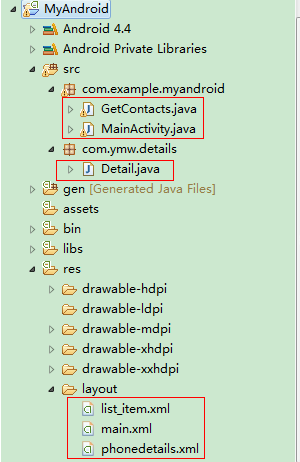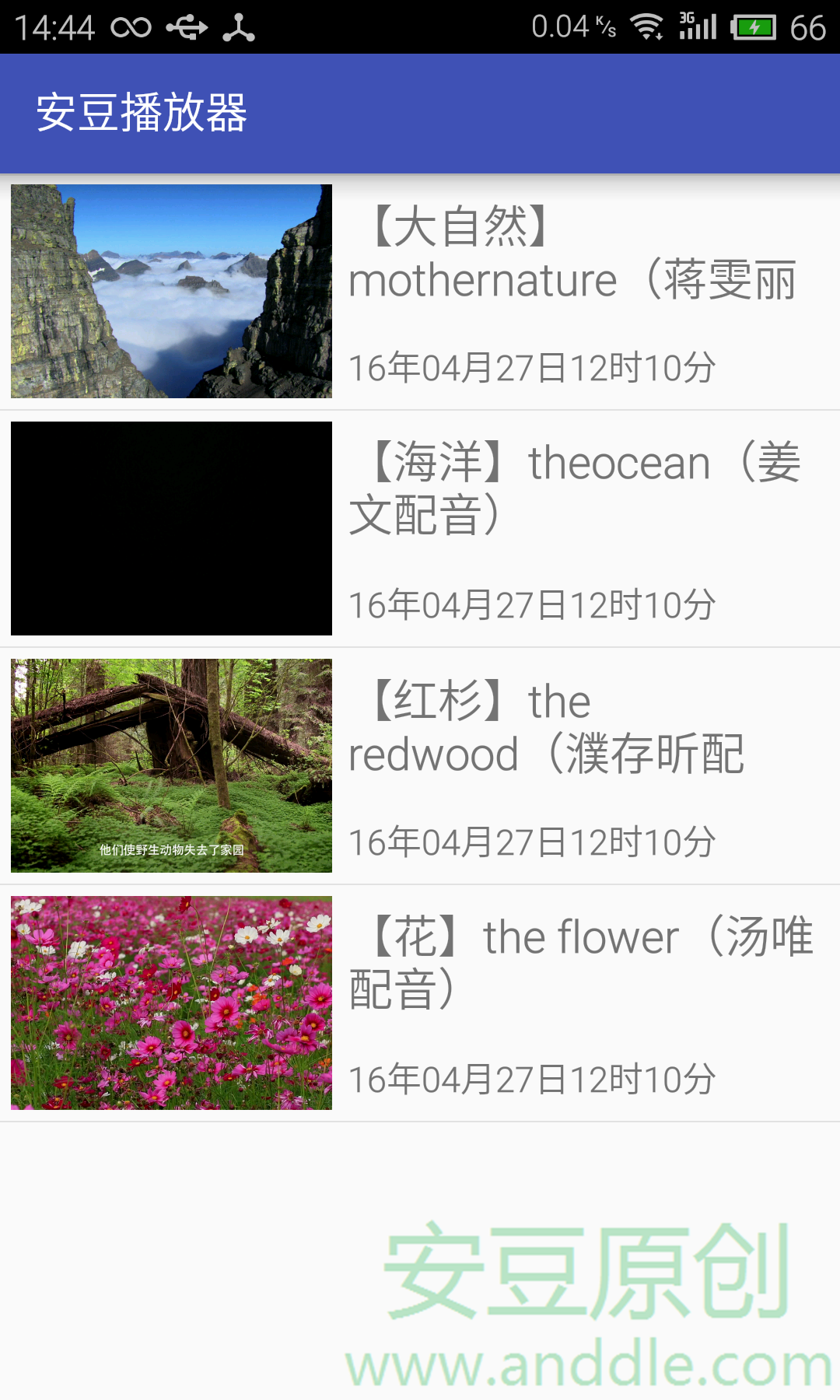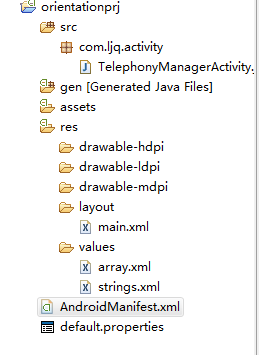編輯:關於Android編程
本文實例講述了Android編程實現讀取手機聯系人、撥號、發送短信及長按菜單操作方法。分享給大家供大家參考,具體如下:
1.Andrid項目結構圖↓主要操作圖中紅色方框內的文件。

2.首先布局代碼如下
a, main.xml 程序運行的主界面,主要用ListView列表控件展示手機聯系人
<?xml version="1.0" encoding="utf-8"?> <LinearLayout xmlns:android="http://schemas.android.com/apk/res/android" android:layout_width="match_parent" android:layout_height="match_parent" android:background="@drawable/bg" android:orientation="vertical" > <ListView android:id="@+id/listView" android:layout_width="fill_parent" android:layout_height="fill_parent" android:layout_marginLeft="5dip" android:cacheColorHint="#00000000" android:divider="@drawable/divider_horizontal_bright" android:paddingRight="5dip" > </ListView> </LinearLayout>
b.list_item.xml ListView的列表項布局文件,相當於展示模版
<?xml version="1.0" encoding="utf-8"?> <LinearLayout xmlns:android="http://schemas.android.com/apk/res/android" android:layout_width="fill_parent" android:layout_height="wrap_content" android:orientation="horizontal" > <ImageView android:id="@+id/imgView" android:layout_width="wrap_content" android:layout_height="wrap_content" android:contentDescription="@string/photo" android:paddingRight="2dip" /> <TextView android:id="@+id/name" android:layout_width="80dip" android:layout_height="wrap_content" android:layout_marginLeft="10dip" android:paddingTop="8dip" android:singleLine="false" android:textAppearance="?android:attr/textAppearanceMedium" android:textColor="#ffffff" /> <TextView android:id="@+id/number" android:layout_width="fill_parent" android:layout_height="wrap_content" android:layout_marginRight="6dip" android:paddingTop="8dip" android:singleLine="false" android:textColor="#ffffff" android:textAppearance="?android:attr/textAppearanceMedium"/> </LinearLayout>
c,phonedetails.xml 長按菜單顯示聯系人詳細布局界面,示例只做了跳轉展示
<?xml version="1.0" encoding="utf-8"?> <LinearLayout xmlns:android="http://schemas.android.com/apk/res/android" android:layout_width="match_parent" android:layout_height="match_parent" android:orientation="vertical" > <TextView android:id="@+id/ymw" android:layout_width="fill_parent" android:layout_height="wrap_content" android:textAppearance="?android:attr/textAppearanceMedium"/> </LinearLayout>
2.Java實現代碼如下
a,MainActivity.java 程序運行的入口文件
package com.example.myandroid;
import java.util.ArrayList;
import java.util.HashMap;
import java.util.Iterator;
import android.app.Activity;
import android.content.ContentResolver;
import android.content.Intent;
import android.database.Cursor;
import android.net.Uri;
import android.os.Bundle;
import android.provider.ContactsContract;
import android.provider.ContactsContract.CommonDataKinds;
import android.view.ContextMenu;
import android.view.ContextMenu.ContextMenuInfo;
import android.view.MenuItem;
import android.view.View;
import android.view.View.OnCreateContextMenuListener;
import android.widget.AdapterView;
import android.widget.AdapterView.OnItemClickListener;
import android.widget.ListView;
import android.widget.SimpleAdapter;
import android.widget.Toast;
import com.ymw.details.Detail;
public class MainActivity extends Activity {
@Override
public void onCreate(Bundle savedInstanceState) {
super.onCreate(savedInstanceState);
setContentView(R.layout.main);
final ListView listView = (ListView) findViewById(R.id.listView);
// 生成動態數組,加入數據
ArrayList<HashMap<String, Object>> listItem = fillMaps();
SimpleAdapter listItemAdapter = new SimpleAdapter(this, listItem,
R.layout.list_item,
new String[] { "imgView", "name", "number" }, new int[] {
R.id.imgView, R.id.name, R.id.number });
listView.setAdapter(listItemAdapter);
// 添加單擊事件
listView.setOnItemClickListener(new OnItemClickListener() {
@Override
public void onItemClick(AdapterView<?> arg0, View arg1, int arg2,
long arg3) {
HashMap<String, String> map = (HashMap<String, String>) listView
.getItemAtPosition(arg2);
String name = map.get("name");
Toast toast = Toast.makeText(getApplicationContext(), "第"
+ arg2 + "項" + name, Toast.LENGTH_LONG);
toast.show();
String phoneNum = map.get("number");
Intent intent = new Intent(Intent.ACTION_CALL, Uri.parse("tel:"
+ phoneNum));
startActivity(intent);
}
});
// 添加長按菜單
listView.setOnCreateContextMenuListener(new OnCreateContextMenuListener() {
public void onCreateContextMenu(ContextMenu menu, View v,
ContextMenuInfo menuInfo) {
menu.setHeaderTitle("長按菜單-ContextMenu");
menu.add(0, 0, 0, "查看詳細");
menu.add(0, 1, 0, "發送信息");
menu.add(0, 2, 0, "刪除聯系人");
}
});
}
public boolean onContextItemSelected(MenuItem item) {
// setTitle("點擊了長按菜單裡面的第"+item.getItemId()+"個項目");
Toast.makeText(getApplicationContext(),
"選擇了" + item.getItemId() + item.getTitle() + "項",
Toast.LENGTH_LONG).show();
int id = item.getItemId();
// 查看詳細
if (id == 0) {
Intent intent = new Intent();
intent.putExtra("ymw", item.getTitle());
intent.setClass(MainActivity.this, Detail.class);
startActivity(intent);
}
// 發送短信
else if (id == 1) {
Uri uri = Uri.parse("smsto://18664599745");
Intent intent = new Intent(Intent.ACTION_SENDTO, uri);
intent.putExtra("sms_body", "ymw-LOVE-yh");
startActivity(intent);
}
// 刪除聯系人
else if (id == 2) {
}
return super.onContextItemSelected(item);
}
// 獲取手機聯系人列表方法一
public ArrayList<HashMap<String, Object>> GetContects() {
ArrayList<HashMap<String, Object>> list = new ArrayList<HashMap<String, Object>>();
Cursor cursor = getContentResolver().query(
ContactsContract.Contacts.CONTENT_URI,
null,
null,
null,
ContactsContract.Contacts.DISPLAY_NAME
+ " COLLATE LOCALIZED ASC");
if (cursor.moveToFirst()) {
int idColumn = cursor.getColumnIndex(ContactsContract.Contacts._ID);
int nameColum = cursor
.getColumnIndex(ContactsContract.Contacts.DISPLAY_NAME);
do {
String contactId = cursor.getString(idColumn);
String disPlayNameString = cursor.getString(nameColum);
// 查看有多少電話號碼 沒有則返回為0
int phoneCount = cursor
.getInt(cursor
.getColumnIndex(ContactsContract.Contacts.HAS_PHONE_NUMBER));
if (phoneCount > 0) {
// 獲得聯系人的電話號碼
Cursor phones = getContentResolver().query(
ContactsContract.CommonDataKinds.Phone.CONTENT_URI,
null,
ContactsContract.CommonDataKinds.Phone.CONTACT_ID
+ "=" + contactId, null, null);
HashMap<String, Object> map = new HashMap<String, Object>();
map.put("imgView", R.drawable.ic_launcher);
map.put("name", disPlayNameString);
list.add(map);
}
} while (cursor.moveToNext());
if (cursor != null)
cursor.close();
}
return list;
}
// 獲取聯系人方法二
public ArrayList<HashMap<String, Object>> fillMaps() {
ArrayList<HashMap<String, Object>> items = new ArrayList<HashMap<String, Object>>();
ContentResolver cr = getContentResolver();
HashMap<String, ArrayList<String>> hashMap = new HashMap<String, ArrayList<String>>();
Cursor phone = cr.query(CommonDataKinds.Phone.CONTENT_URI,
new String[] { CommonDataKinds.Phone.CONTACT_ID,
CommonDataKinds.Phone.DISPLAY_NAME,
CommonDataKinds.Phone.NUMBER,
CommonDataKinds.Phone.DATA1
// CommonDataKinds.StructuredPostal.DATA3,
}, null, null, null);
while (phone.moveToNext()) {
String contactId = phone.getString(phone
.getColumnIndex(CommonDataKinds.Phone.CONTACT_ID));
String displayName = phone.getString(phone
.getColumnIndex(CommonDataKinds.Phone.DISPLAY_NAME));
String PhoneNumber = phone
.getString(phone
.getColumnIndex(ContactsContract.CommonDataKinds.Phone.NUMBER));
String address = phone.getString(phone
.getColumnIndex(CommonDataKinds.Phone.DATA1));
// 以contactId為主鍵,把同一人的所有電話都存到一起。
ArrayList<String> ad = hashMap.get(contactId);
if (ad == null) {
ad = new ArrayList<String>();
ad.add(displayName);
ad.add(PhoneNumber);
// ad.add(address);
hashMap.put(contactId, ad);
} else {
ad.add(PhoneNumber);
}
}
phone.close();
ArrayList<String> tmpList;
String tmpStr = "";
int k;
Iterator iter = hashMap.entrySet().iterator();
while (iter.hasNext()) {
HashMap.Entry entry = (HashMap.Entry) iter.next();
Object key = entry.getKey();
Object val = entry.getValue();
tmpList = (ArrayList) val;
tmpStr = "";
for (k = 1; k < tmpList.size(); k++) {
tmpStr = tmpStr + tmpList.get(k) + ',';
}
tmpStr = GetString(tmpStr);
HashMap<String, Object> tmpMap = new HashMap<String, Object>();
tmpMap.put("name", tmpList.get(0));
tmpMap.put("number", tmpStr);
tmpMap.put("imgView", R.drawable.ic_launcher);
items.add(tmpMap);
}
return items;
}
private String GetString(String str) {
String strLast = "";
int i = str.lastIndexOf(",");
if (i > 0) {
strLast = str.substring(0, str.length() - 1);
}
return strLast.replace(" ", "").replace(",", "\n").replace("+86", "");
}
}
b,Detail.java 主界面長按菜單顯示聯系人詳細的跳轉界面,接受主界面傳來的參數
package com.ymw.details;
import com.example.myandroid.R;
import android.app.Activity;
import android.content.Intent;
import android.os.Bundle;
import android.widget.TextView;
public class Detail extends Activity {
@Override
protected void onCreate(Bundle savedInstanceState) {
// TODO Auto-generated method stub
super.onCreate(savedInstanceState);
setContentView(com.example.myandroid.R.layout.phonedetails);
Intent intent = getIntent();
String strPara = intent.getStringExtra("ymw");
TextView tView = (TextView) findViewById(R.id.ymw);
tView.setText(strPara);
}
}
3.獲取手機聯系人和撥號發短信等需要配置權限
在AndroidManifest.xml文件中的application節點上加入如下代碼
<!--添加權限--> <uses-permission android:name="android.permission.SEND_SMS"/> <uses-permission android:name="android.permission.CALL_PHONE"/> <uses-permission android:name="android.permission.READ_CONTACTS"/>
4.使用Android模擬器或連接Android智能手機運行本程序可以看到手機聯系人列表,
單擊某個聯系人會直接撥號,長按某個聯系人會出現菜單選項,可以選擇發送短信。
希望本文所述對大家Android程序設計有所幫助。
 Android使用adb命令往模擬器裡安裝軟件
Android使用adb命令往模擬器裡安裝軟件
我將模擬器解壓到C:\android-sdk-windows\在C:\android-sdk-windows\platform-tools這個文件夾裡有個a
 【干貨分享】關於 Android N 的那些事兒
【干貨分享】關於 Android N 的那些事兒
今年3月,Google 破天荒提前半年發布了 Android N 開發者預覽版。當然,作為一個不合格的谷粉並沒有第一時間體驗安裝,因為至今仍然能夠回憶起來去年今日此門中(
 布局與控件(七)-ListView知多少(上)
布局與控件(七)-ListView知多少(上)
第9節 ListView在應用界面當中,經常需要使用列表來展示內容。Android SDK提供了ListView控件,來實現這種效果。ListView需要和Adapter
 Android中TelephonyManager類的用法案例詳解
Android中TelephonyManager類的用法案例詳解
本文以案例形式分析了Android中TelephonyManager類的用法。分享給大家供大家參考。具體如下:目錄結構:main.xml布局文件:<?xml